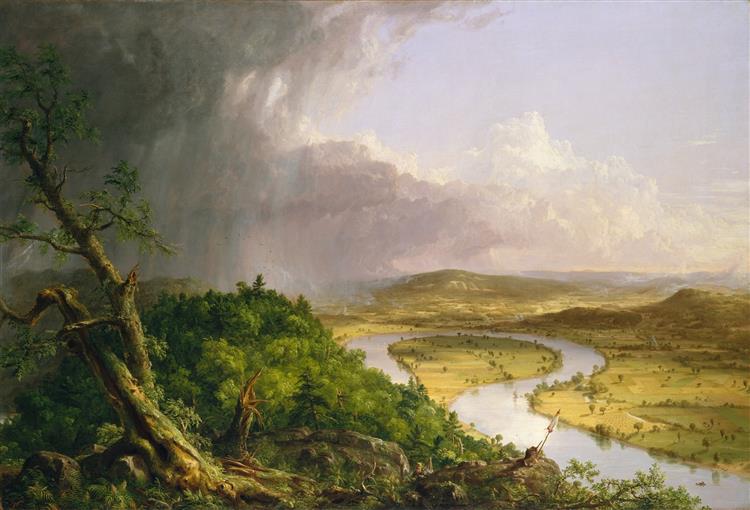
Hudson River School
School or Group
The Hudson River School was neither a school nor art movement in the contemporary sense of the term, but a group of landscape painters who began working in the Hudson River Valley of New York State. The name for the group has been variously attributed to either the art critic Clarence Cook or the artist Homer Dodge Martin, but, in any case, it was coined as a disparaging term in the 1870s to suggest that the group's style and subject matter were passé and provincial.
The earliest works that could be categorized as Hudson River School paintings were by Thomas Doughty, one of the first American landscape artists, who painted quiet lyrical scenes of the region. The most famous and influential of the group, however, was Thomas Cole; it was under his leadership that the group became well-known and respected, and thus, he is most often credited as the group's founder. Cole invested the landscape with symbolism, suggesting that natural scenes could be transformed into meaningful allegories, as well as immersive and transformative experiences for the viewer. With careful attention to realism and precise illusionism, as well as complex messaging and awe-inspiring vistas, his canvases could be appreciated on both intellectual and emotional levels.
When Cole died in 1848, the leadership of the Hudson River School fell to Asher B. Durand. Influenced by the landscapes of the British Romantic painter John Constable, Durand shifted the group's style towards more naturalistic painting. As head of the National Academy of Design, he stressed careful observation and representation. He encouraged scenes of quiet communion with nature rather than dramatic allegory.
The second generation of Hudson River School painters centered around Durand, Albert Bierstadt, John Frederick Kensett, Sanford Robinson Gifford, along with Cole's only student, Frederic Edwin Church. The second generation of Hudson River School painters left the New York area to explore more far-flung regions of America. Their painting documented westward expansion and reinforced the concept of Manifest Destiny. During the Civil War, their majestic images of an unspoiled West provided hope for post-war reconciliation and the promise of expanses of wild country, full of promise and unscarred by battle.
Long considered a profitable, but lowly, subject for serious artists (since it involved merely copying what was seen), landscape painting received new attention in the mid-19th century. Like Romantic painters in Britain and Germany, Hudson River School artists embraced the landscape as a meaningful subject, precisely as industrialization began to change terrains and reshape man's connection to his environment. The Americans both championed these forces of modernization and lamented what was lost in the name of "progress."
Generations of American painters had returned to Europe for training and adopted the styles and subjects of Old World artists. The Hudson River School painters desired a more native tradition, painting recognizably American scenes. Personally and professionally, they formed networks with writers and philosophers to create a distinctly American culture.
In the 1870s, the Hudson River School fell out of fashion, as the influence of the Barbizon School and Impressionism dominated the art world. In comparison, Hudson River School realism and mimesis seemed out of date, sometimes sentimental, or of merely historical interest. Yet, while artistically unfashionable, the school had a profound cultural influence, popularizing its wilderness ideal, which encouraged preservation efforts and the development of national parks. Olana, Church's expansive estate overlooking the Hudson River, has been preserved as a national historic landmark. Home to a museum today, visitors can tour Church's home and the grounds and view installations of historical and contemporary art inspired by the Hudson River School. Thomas Cole's home in the Catskills has also been maintained as a museum.
Regionalism or American Scene Painting, drew upon the model of the Hudson River School as it developed in the American Midwest during the 1930s. Artists like Thomas Hart Benton, Grant Wood, and John Steuart Curry sought to create modern but distinctly American art. They adopted the rural landscapes, realistic detail, and regional identity that had characterized the earlier movement.
In its depictions of wilderness and sublime views, modern photography was also influenced by the Hudson River School, particularly as seen in works like Ansel Adams' The Tetons and the Snake River (1942).
In the postwar years, the Hudson River School painting was both critiqued and emulated. In the 1960s, a new generation of photographers like Ed Ruscha and Robert Adams deliberately posited their photographs of banal suburban modernity as a challenge to dramatic and heroic visions of nature. However, with the development of Land art and environmental activism in the 1970s, the style came back into vogue.
Sources:
www.theartstory.org
Wikipedia:
https://en.wikipedia.org/wiki/Hudson_River_School
